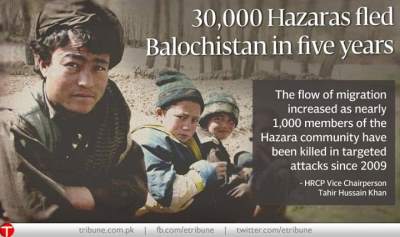NOTE: This story is published on Express News. We are ONLY saving it for future legal purposes.

QUETTA:
With a surge in violence in Balochistan, members of minority groups have increasingly sought shelter in other parts of the country. Nearly 30,000 members of the Hazara community have migrated in the last five years, according to Human Rights Commission of Pakistan (HRCP) Vice Chairperson Tahir Hussain Khan.
Speaking with The Express Tribune, Khan said the flow of migration increased as nearly 1,000 members of the Hazara community have been killed in targeted attacks since 2009.
Khan, who is also president of the HRCP’s Balochistan chapter, added that more than 10,000 Hindus have also fled the province as abductions-for-ransom have become routine over the last three years here.
Members of the Hazara community leaving Quetta and other parts of the province comprise businessmen, highly educated workers and senior government officials, amongst others, he said. Discussing sectarian violence in the province, Khan warned, “This conflict can turn into a civil war if it is not addressed properly at this stage.”
The Hazara community has been confined to two localities in Quetta, he pointed out – a four-kilometre radius on Alamdar Road and an 11km area within Hazara Town – after the provincial government set up security checkpoints around these residential colonies.
“They are physically isolated from the rest of the city’s population,” he said. “They are not aware of how long they will continue to be confined in such a way.” He pointed to the growing presence of religious parties in the country as a possible reason for increasing sectarian conflict.
Within classrooms, Khan said school syllabi create rifts between students of different faiths and sects, particularly when religious extremist thought is inculcated in educational institutions.
Published in The Express Tribune, April 12th, 2014.
Correction: An earlier version of the article was carrying an incorrect picture. The error has been rectified.
admin
Latest posts by admin (see all)
- ISIS claims gruesome murder of 10 Hazara coalminers in Pakistan - January 5, 2021
- Farewell Hussain Babai - December 20, 2020
- Hazaras categorically reject US-engineered ‘Taliban talks’ in Qatar - September 12, 2020